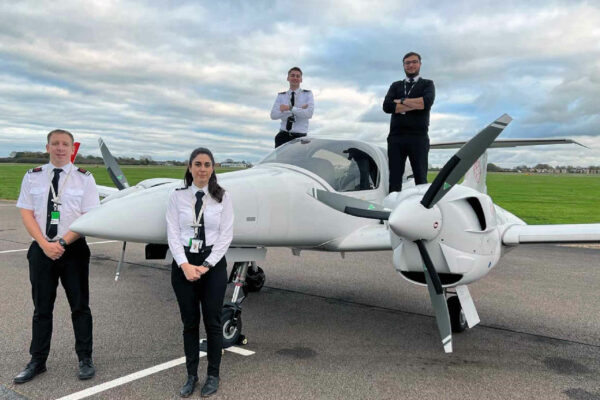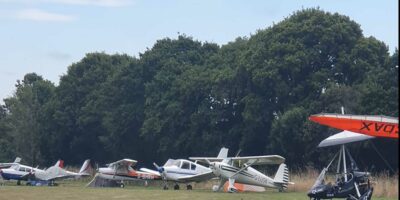My last couple of columns have been on airspace topics and, originally, I was planning this month to turn my attention elsewhere. But I decided there was more to be discussed within the vast subject of how our skies are managed.
There is much talk of modernisation and the future, but while the strategic direction for airspace is now broadly set, there are still a lot of tactical activities, within which the needs of different stakeholders must be balanced. The following is a roundup of the current scene – and what may be in the pipeline.
AMS support fund
As reported a few days ago on FLYER, there is another round of funding available via the Airspace Modernisation Strategy (AMS) support fund. The fund is intended for projects that support the delivery of the AMS goals. Since December 2021, seven projects have been sponsored, with a grant total of around £2.1 million.
Four of the previously funded projects have relevance to GA and include the electronic conspicuity (EC) interoperability trials at Goodwood, the ‘Digital Intentions’ project for the online transmission of VFR flight intent data, and the trial of ADS-B Obstruction Beacons on 978 MHz.
Several airports have also received funding for analysis of aircraft noise distribution trade-offs, something that will become increasingly important as our airspace continues to evolve. The criteria for applying are fairly open, so any company or organisation with a relevant technical enabler or research project could be eligible.
Consultation on CAP1616
You may be wondering what the CAP 1616 consultation is about – CAP 1616 is the document that sets out the Airspace Change Process (ACP) and is currently up for review. The ACP covers most forms of instrument flight procedures and regulated airspace in the UK, not just new controlled airspace.
The basic principle is that all changes to airspace must have a sponsor, which is normally an airport or air navigation service provider (ANSP), but can be a variety of stakeholders, so long as they set out a credible case for how the airspace entity could be added, removed or modified.
CAP 1616 has been with us since 2017 and replaced the earlier CAP 725. There were several drivers for CAP 725’s replacement, including concerns over a lack of transparency, inconsistent quality of change proposals and sponsors not meaningfully addressing the concerns of other stakeholders, both on the ground and in the air.
CAP 1616 introduced the ‘gateway’ concept, designed to ensure proposals did not proceed beyond a particular stage without the CAA being satisfied the relevant requirements had been met.
A small number of ACPs continue under CAP 725, due to them having started prior to the end of 2017. The CAA’s decision in December 2022 to reject Biggin Hill’s application for an instrument approach procedure (IAP) to their Runway 03, seven years since the proposal started, will hopefully be one of the last ACPs to get so far without ultimate success.
The current review of CAP 1616 is quite focused on the structure of the process and document. I think the bigger picture may be lacking a bit – the concerns that led to the publication of CAP 1616 were valid, however there is widespread concern from sponsors that the process has now become a barrier to progress, especially as the government and CAA are pushing a wider airspace modernisation agenda.
Another issue is that CAP 1616 enlarged the scope of what normally triggers the ACP. While, in principle, this expansion was good for transparency, both sponsors and the CAA have struggled with the sheer volume of activity required.
The deadline for the consultation has now been extended to 19 March.
Airspace Change Proposals
There are currently around 200 individual ACPs registered with the CAA, and this includes everything from trivial updates of IAP charts to new controlled airspace. The number of ACPs has been growing steadily for the last few years, partly due to CAP 1616 broadening the net, but also a general increase in activity.
Between Remotely Piloted Air Systems (RPAS), space launches and the AMS, it feels busy right now. However, due to Covid, there are still a lot of proposals at early stages of development – almost all potentially relevant to GA have yet to go to public consultation.
The ACPs relating to the AMS airspace redesign are still too young for us to know what the final outcomes will look like. In terms of controlled airspace (CAS) volumes, I see a potentially mixed picture.
On the one hand, better integration of airspace routes should see efficiencies, but I suspect there will be a tendency for individual airports to try and reduce interdependencies by spreading tracks further out and this could result in more CAS rather than less.
There is a real drive to get routine continuous climb and descent in the London TMA and in some places, this may be difficult to achieve within the existing airspace footprints.
Quite a few ACPs are of a temporary nature and do not really affect normal aviation, however some potentially do. The long-standing danger areas over the Channel, near Lydd and Dover for example, are under ACP to make permanent, however consultation has not yet started.
Other RPAS corridors are at various stages of proposal, with many being follow-ons from trials during covid. Temporary ACPs are normally required for space launches although, except for the recent one from Newquay, most of the others planned for 2023 will be in Scotland.
Land’s End has applied to add an ADS-B zone to the existing Radio Mandatory Zone (RMZ) that encompasses the area between Land’s End and the Scilly Isles. Timelines have not been confirmed, but if successful, this would make it one of the first ADS-B zones (rather than Mode S) in the UK.
The Land’s End corridor could then be monitored via Flight Information Display (FID). There was also talk of a trial ADS-B zone over the Inner Hebrides last year, but I’m not sure if that is still planned.
On a more GA-relevant note, the outcome is awaited on the long running project for GNSS approaches to Sherburn-in-Elmet, and hopefully Leeds East Airport will follow shortly after. Sywell has also applied to regain their GNSS approach, after withdrawing it when AFIS provision was removed from the aerodrome.
More controlled airspace?
Many will remember the abortive attempts around 2017 for increased CAS at Brize Norton, Oxford and Exeter airports, with the CAA rejecting all three proposals.
Brize has now restarted an application under CAP 1616. The long running concern at Brize is that the existing CTR is too small and that there is no controlled airspace protection for joining the adjacent airways.
I think Brize’s original ambitions were too high, and the quality of the proposal documentation was surprisingly poor. There is no indication yet as to what it has in mind this time, only the intention for new CAS.
Exeter made some progress on a new proposal during 2021, however it seems that as of last year, the CAA was not satisfied that the CAP 1616 criteria for the applicable gateway in the process had been met.
Unlike Brize, Exeter has published some design options, ranging from a CTR that is only slightly bigger than the existing ATZ, all the way up to the multi-layered proposal that was originally rejected. No date has appeared for public consultation though, so again it’s a ‘watch this space’ situation.
Airspace classification review
After perhaps an inauspicious start a few years ago, the CAA airspace classification review process continues to move across the country. After addressing the Cotswolds, the evidence session for Barnsley concluded in January this year. The Barnsley review may result in some proposals around the Manchester Low Level Route.
What is interesting about the classification review is that prior to the establishment of the CAA classification team, routine reviews of airspace utilisation in the UK were not really undertaken and although the team has limited powers to change airspace, the process does generate a reasonable amount of evidence, which is then made public.







